 The term “threat vector” is traditionally used in the cybersecurity and InfoSec space, and refers to vulnerabilities that expose organizational networks and endpoints (e.g. computers, laptops, employee-used smartphones, etc.), to malware, viruses, and other hazards.
The term “threat vector” is traditionally used in the cybersecurity and InfoSec space, and refers to vulnerabilities that expose organizational networks and endpoints (e.g. computers, laptops, employee-used smartphones, etc.), to malware, viruses, and other hazards.
However, the threat vector concept is just as important and applicable when it comes to web and social media governance. Cyber criminals, counterfeiters, rogue current employees, and disgruntled ex-employees are increasingly turning their attention to these digital points of presence — and compromising them with alarming ease. That’s the bad news.
The good news, is that awareness along these lines is growing, and more businesses of all sizes — regardless of whether they are B2C, B2B, or B2B2C — are implementing a comprehensive and robust web presence management strategy. This strategy helps reveal the totality of their threat vectors, and more importantly, enables them to effectively plug holes and fortify vulnerabilities.
Below are three of the biggest threat vectors that web presence management uncovers and protects:
-
Unowned Points of Presence
Some — though certainly not all — businesses are aware of the points of presence that they own, such as their website, active social media properties, and so on (with this being said, we have worked with many businesses that are shocked to discover their web and social media presence is exponentially larger than they believed!).
However, there are typically an array of unowned points of presence that have been created by customers, third parties (e.g. Yelp, Wikipedia, Glassdoor, etc.), and so on that need to be included in the overall inventory. Although businesses cannot directly control the content on these platforms or websites, knowing that they exist is essential to ensure that negative content is strategically neutralized, and that libelous remarks are dealt with appropriately.
-
Domain Names
Just as how many businesses are amazed (and alarmed) to discover that their relatively small social media footprint is actually large and expansive, they are just as shocked to learn that at some point someone in their organization — or someone outside their organization, like a competitor or cyber criminal — has registered various domain names associated with the brand. These are typically domain names with alternative spellings, various top-level domains (.net, .com, .biz and so on), and so on. What’s more, derogatory domain names can also be part of the mix, such as www.[companyname]sucks.com.
Web presence management brings to the surface all domain names related to a brand and a business, so they can be managed accordingly. For example, it may be necessary to establish redirects so that customers and other visitors always end up in the right place, just as it may be necessary to contact search engine compliance teams or launch legal action to shut down domains that are fraudulently representing a brand.
-
Non-Compliant Points of Presence
Businesses in regulated fields (e.g. legal, health care, etc.) must meet a higher standard of communication compliance that was relatively straightforward in the pre-web days, but is now a difficult and complex process. Indeed, even a single discussion thread or web page buried deep within a website that gets very little traffic could, if it contains erroneous information, expose a business to fines, sanctions and/or reputation damage.
Web presence management puts the spotlight on these points of presence, and gives business the opportunity to proactively make changes (or remove content) to ensure that they are in compliance with prevailing regulations, protocols, best practices and so on.
Learn More
The above are just some of the threat vectors that web presence management uncovers and helps businesses fortify and protect. To learn more about safeguarding and strengthening your business, brand, and points of presence across the web and social media landscape, contact the Brandle team today. Your consultation with us is free.
For more information on social media governance and how to create and implement a plan, download our FREE eBook:









